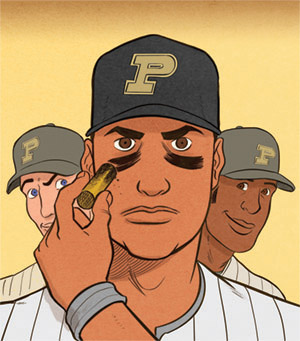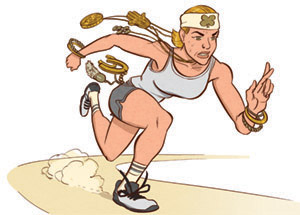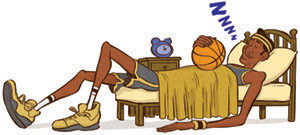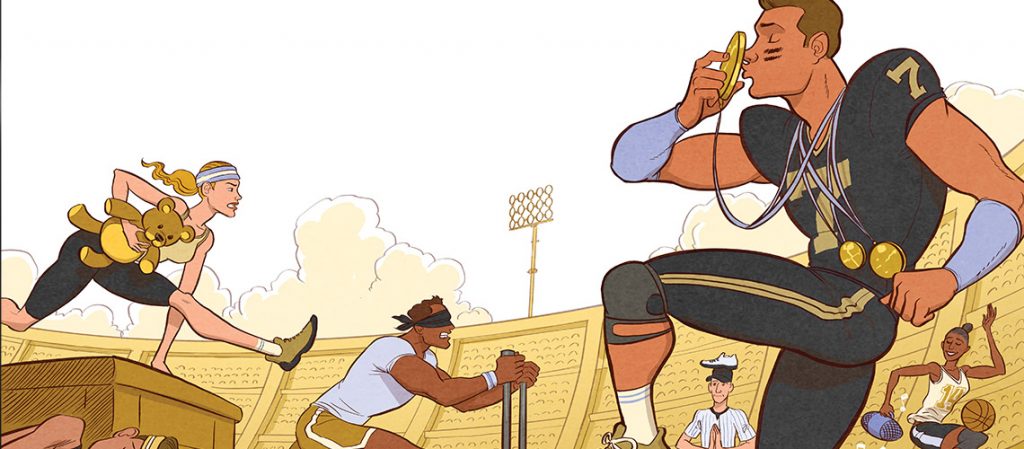From dirty socks to pickle juice, athletes share the pregame rituals that calm their nerves and give them a competitive edge
The tics, wipes, bends, shuffles, and flexes you might see at the free throw line or in the batter’s box are only momentary rituals that basketball players, baseball players, and other athletes use aiming to gain a competitive edge. Even more elaborate are the sometimes season-long superstitions that players, coaches, and even entire teams engage in, all with the belief that it will help tilt the field in their favor.
It’s the same at Purdue, where athletes have followed a strict ritual putting on socks, getting pregame naps, or even lighting tiny fires in hopes of finding that competitive advantage.

For a decade, Boilermaker baseball players have tried to spark their performance by igniting tiny flames in the clubhouse or in the dugout before a game. The team trainer keeps lighters and wine corks on hand so that players can make the Boilermakers’ version of eye black, the substance players use under their eyes to try to minimize glare from the sun or overhead lights.
“Whenever someone is doing it for the first time, they’re like, ‘Is this going to burn?’” says Milo Beam, a current outfielder on the team. “I’m like, ‘No, it’s just warm. You light it on fire, blow it off, let it cool off for a sec, and then you’re good to go.’”
The tradition is said to have been created by Drew Madia (HHS’10), the son of John Madia (A’78), director of baseball operations. Drew Madia was named to the All-Big Ten tournament baseball team as a senior. The tradition was passed on to other players after Madia graduated. Two years later, in 2012, the Boilermakers were Big Ten champions.
It’s not surprising that Beam is among the players carrying on the tradition, given that he always puts on his right sock first — before practices as well as games — and always finishes warm-up rounds of playing catch with a certain behind-the-back flip of the ball from his glove. “It sounds crazy, but there’s more than one guy in the clubhouse that’s like that,” he says. “I’m not super-superstitious, but I just like to have a routine, and I like to do things the same way. I usually give myself enough time so I’m not scrambling and putting my left sock on first.”
David Bokhart (LA’00), a four-year member and two-year captain of the Boilermaker men’s soccer club team, says he’s not overly superstitious but admits that in high school he started wearing a certain pair of socks for each game, as long as they would last. “It probably just started out of necessity with shoes that were too big and needing to fill the shoes,” he says. “It just gave you the feeling of a little bit of control,” he says.
Bokhart was the head men’s soccer coach at the Indiana Institute of Technology in Fort Wayne and now is the school’s associate athletic director. He says his players would bring adopted mascots on the team bus for game trips. They were often stuffed animals that one of the players had won at a fair. And the players gave the mascots names, Bokhart says, “most of which I can’t repeat.”

Do such habits seems a little crazy? Maybe it’s actually predestined.
“To understand ritualized behavior, start with the fact that the brain is a meaning-making machine continually trying to link cause and effect. This is evolution at work,” Steven Kotler, a bestselling author and a researcher in “ultimate human performance,” recently wrote. “On a hunt, it helps to remember that the last time you went out, when the bushes started shaking, there was a rabbit inside. And if you happened to pound your spear on the ground twice, perhaps to improve your grip, before you discovered that rabbit, your brain may try to connect those dots.”
Indeed, there are reasons to believe that rituals and superstitions have their place. A 2010 study led by University of Cologne psychologist Lysann Damisch, which used four experiments, found that “activating a superstition boosts participants’ confidence in mastering upcoming tasks, which in turn improves performance.”
Similarly, there’s a widespread belief that routines can help relax athletes and improve their concentration.
Lauren Link (HHS’11), director of sports nutrition at Purdue and a player on the Boilermakers’ 2007 Big Ten Tournament championship soccer team, says that as a player, she always put on her left shoe first, and she and two of her teammates had to do a pregame drill where they caught the ball between their legs. Surprisingly, perhaps, none of her rituals involved food.
Link agreed that rituals are relaxing — the proof being what happens when you don’t do them.
“As the stakes start to get higher as you go through your career, those little things are maybe what you latch onto to try to give yourself the edge,” she says. “But if you ever didn’t do your routine, it was like, ‘Oh, gosh,’ and then you feel nervous.”
“As the stakes start to get higher as you go through your career, those little things are maybe what you latch onto to try to give yourself
– Lauren Link
the edge.”
Link has carried on her habits. She recalls frantically texting her husband to bring her lucky Boilermakers football bracelet down to the field to her during a recent game when she had forgotten it. “As I’m talking,” she says, recalling the texting experience, “I’m realizing I’m a very superstitious person.”
Football players, by the way, can have some strange rituals. One current Boilermaker, she confides, downs a pickle-stirred mix of beet and pickle juice before each game, “which is so disgusting to me.”
Starting in high school, two-hour pregame naps were a ritual for Walter Jordan (-HHS’78), a member of the Indiana Basketball Hall of Fame who was a two-time All Big Ten Conference player at Purdue and played for one season in the NBA with the Cleveland Cavaliers. It sounds paradoxical, but Jordan says he would become so excited on game day that he had to calm himself by napping. Fortunately, he had understanding teammates and coaches.
Jordan was bused about 20 miles to Fort Wayne Northrop High School, so he couldn’t go home after school for a pregame nap. “We had a lot of issues when they started the first busing, a lot of ignorance going on,” Jordan recalls of the integration efforts. “But we got to know each other through sports.”

Jordan would get his slumber at the home of a teammate or coach who lived within walking distance of school. He says the parents who took him in “would feed me, and I would take a nap. Their parents treated me like I was one of their own children.” The rest, meanwhile, followed by music, “would take my mind off basketball, just put me in a different place.”
Even more important was a medallion Jordan began wearing starting in his senior year of high school, after his mother passed away.
“It seemed like I had superpowers from that point on, after that first game,” Jordan says. “I always say that my mom was there; that got me through so much.
“What I heard was what my momma said in her hospital bed — ‘That boy is going to be a pro.’ She told my dad that. That inspired me to no end. It made me fearless.”
Danielle Campbell (LA’09), a former Purdue basketball player who played on teams that went to the Sweet Sixteen and Elite Eight of the NCAA tournament, says rituals can backfire.
“At the end of the day, it comes down to what’s happening on the floor and who puts more buckets in the basket,” she says. “If something is off or missed in those rituals — a lot of the game is mental, so that could throw off your game even before it starts” if you take rituals too seriously.
That being said, Campbell, who is now a volunteer coach for the girls basketball team at her high school alma mater, Whitney Young in Chicago, relied on habits and some superstitions as a Boilermaker. A nap and a peanut-butter-and-jelly sandwich before each game were non-negotiable.
“That was every single game that I played. Anything with peanut butter is like gold,” she says.
There were also team rituals. In the locker room before a game, Campbell and her teammates would exchange “happy notes”: simple messages to help inspire each other to excel. As a team, the Boilermakers did a certain clap as they were running onto the court before a game, and then a group dance at mid-court just before the starting lineups were announced.
“When the whole team does it, I think it translates on the court, too,” Campbell says. “We’re doing things together, we’re moving as a unit. When you get in the trenches, it builds that camaraderie — your teammates got your back.”

